Description
IMPROVING MAINTENANCE AND QUALITY OF PUBLIC PROPERTIES IN NIGERIA (AKUKU TORU LOCAL GOVERNMENT AREA IN RIVERS STATE) – 2023
CHAPTER ONE
1.0 INTRODUCTION
This research is on Improving maintenance culture and quality of public properties in Nigeria (Akuku Toru local government area in rivers state). Maintenance culture is an attitude which is sadly lacking in Nigeria, whether in the home, office, school or factory. Mbamali 2003 added that poor maintenance culture has become a widely recognised problem in Nigeria. Maintenance culture in Nigeria is the lowest around the World, especially, in our principal towns and cities. In the rural areas, the story is different and pleasant to hear. The traditional practice of communal clearing of community owned places such as market; playground is in almost every village. In private homes it is customary to refurbish building interiors with mixtures of cow dung or natural red clay. The end result is attractive and totally indigenous. According to Wahab 1995 the nation accords low priority to property management. Faworaja 1996 In Mbamali 2003 asserted that we have no maintenance policy and therefore no such culture exists. Neglect of maintenance has accumulated consequences in rapid increase in the deterioration of the fabric and finishes of a building, accompanied by a harmful effect on the contents occupants Seeley, 1987. Inadequate maintenance culture is a peculiar feature of almost every building in Nigeria. According to Rotimi and Mtallib 1995 is partly due to poor maintenance culture on one hand and partly due to the absence of an appropriate benchmark. Gurjit 1990 asserted that lack of proper maintenance culture bring the life of a building last before reaching the total obsolescence state. The declining maintenance culture in Nigeria and its effect on buildings has become a major problem to both the public and private sectors. This study examines the trend of maintenance culture and its effect on construction, and quality of materials, design and facilities as well as services used during constructing the building. A great portion of a Nation wealth is evident in the total value of its buildings; it is also an important factor in the production of the building to be preserved. A poorly maintained building in a decaying environment depresses the quality of live and contributes in some measures to anti social behaviour which threatens the sociopolitical environment it finds itself in. This research is necessitated to look at the existing knowledge about continuous negligence on maintenance and its impact on construction as been suffered by residential buildings.
According to Sidney 1991 permanent structure requires less attention than temporary ones, any house owner will confirm that even the best constructed building needs constant attention. If the attention is delayed, what started as being something very minor is liable to turn quickly into an expensive operation Similarly, Seeley 1987 asserted that no building can exist throughout its span without one form of maintenance or the other; it is to say that much can be done at the design stage in order to reduce the amount of subsequent maintenance work. According to Seeley 1997 maintenance work on a building should commence from the day the contractor leaves the site.
The necessity for maintenance work on buildings is noted in the fact that all buildings, as well as the materials and components therein, deteriorate or suffer loss in aesthetic, strength and or functional value, with exposure to the elements of weather over time. The appearance and life span of a building and also the quality of the materials would be affected depending on the manner to which maintenance is adhered to, in the building Seeley, 1987. If the design process is to be enhanced, the building team need to come together and contribute towards the buildings maintainability at the project inception rather than leaving it for the maintenance personnel at the end of construction to battle with the curative measure Adejimi, 1998. This sometimes according to Seeley 1997 causes frustration and annoyance to maintenance personnel when taking over new buildings and finding themselves faced with bad details, poor choice of finishes, materials and components and lack of basic information about the building and its services.
According to Cornick 1996 the root cause of the problems that the construction industry and its clients experience lie in the division of the responsibilities between the design aspects and the construction aspect Alexander 1996 was direct in his criticism of the organization of the construction industry noted that the industry is unique in that the design process is separated from production. The successful completion of any building depends on many things, few of which are as important as the designer contractor relationship. The two parties must be willing to work together so that the clients get maximum benefit from their joint expertise. The contract should feel able to contribute to the design process in matters relating to construction practice and the designer should be willing to receive, analyse and subsequently act on such recommendations.
1.1 BACKGROUND TO THE STUDY
The Advanced Learners Dictionary defines maintenance as the process of protecting or preserving someone or something, or the process of keeping something in good condition. Culture, on the other hand, is a way of life, a lifestyle, customs, traditions, habits that portray the attributes of a person/people.
Maintenance culture is an attitude which is sadly lacking in Nigeria, whether in the home, office, school or factory. Mbamali2003 added that poor maintenance culture has become a widely recognized problem in Nigeria which has poorly affected the quality of public properties.
Public property is property that is dedicated to public use and is a subset of state property. The term may be used either to describe the use to which the property is put, or to describe the character of its ownership owned collectively by the population of a state. This is in contrast to private property, owned by an individual person or artificial entities that represent the financial interests of persons, such as corporations. State ownership, also called public ownership, government ownership or state property, are property interests that are vested in the state, rather than an individual or communities Wikipedia, 2015.
Maintenance culture in Nigeria is one of the lowest around the world, especially, in our principal towns and cities where the majority of public properties are located. In the rural areas, the story is different and pleasant to hear. The traditional practice of communal clearing of community owned places such as market playground is in almost every village and in private homes. Also, it is customary to refurbish building interiors with mixtures of cow dung or natural red clay. The end result is attractive and totally indigenous. According to Wahab1995 the nation accords low priority to property management leading to neglect of public properties. Mbamali2003 asserted that we have no maintenance policy and therefore no such culture exists. Neglect of maintenance has accumulated consequences in rapid increase in the deterioration of the fabric and finishes of a building, accompanied by a harmful effect on the contents occupants Seeley, 1987. Inadequate maintenance culture is a peculiar feature of almost every public building in Nigeria. According to Rotimi and Mtallib1995 is partly due to poor maintenance culture on one hand and partly due to the absence of an appropriate benchmark. Gurjit1990 asserted that lack of proper maintenance culture bring the life of these public building last before reaching the total obsolescence state. The declining maintenance culture in Nigeria and its effect on public buildings and all other properties has become a major problem to the government at various levels. This study examines ways of improving maintenance culture and its effect on quality of public properties
A great portion of a nation wealth is evident in the total value of its public properties and buildings; it is also an important factor in the production of the building to be preserved. A poorly maintained building in a decaying environment depresses the quality of live and contributes in some measures to anti social behaviour which threatens the sociopolitical environment it finds itself in
According to Stephen 2002public properties services rarely perform as well as desired. The causes emanate from deficiencies in design, construction, commissioning and maintenance, many researchers have also observed that the generators of maintenance problems could be looked upon hascaused during the design stage or construction stage or initiated during the usage stage or the users carefree attitudes Bad maintenance culture which will eventually deteriorate the condition of the property.
He further said that all these could be planned for during the design stage. Maintenance problems though do manifest during the use of the building, their causes might be during the design stage. These made Dekker2002 to assert that thinking on the maintenance should start in the design phase. According to Speight 2000, it is at the design stage that the maintenance burden can be positively influenced for better or for worse. Where the designer fails to make adequate consideration for minimizing maintenance problems, it always turns out to be a big problem when the building is eventually occupied for usage, the consideration for effective maintenance as one of the parameters for the building design. Seeley 1997 also said that a skilful design can reduce the amount of maintenance work and also make it easier to perform, since good maintenance begins on the drawing board.
1.2 STATEMENT OF THE PROBLEM
Oladimeji 1996 further described maintenance of public properties as the combination of any continuous actions carried out to retain a property in or restore it to an acceptable condition. Onwuka 1989 stated that maintenance culture is concerned with the planning and control of construction resources to ensure that necessary repairs and renewal are carried out with maximum efficiency and economy to enhance the quality of the property. However, the researcher is examining the ways of improving maintenance culture and quality of public properties in Nigeria.
1.3 OBJECTIVES OF THE STUDY
The following are the objectives of this study:
- To examine ways of improving maintenance culture in Nigeria.
- To determine ways of enhancing the quality of public properties through improved maintenance culture.
- To determine the factors affecting maintenance culture in Nigeria.
1.4 RESEARCH QUESTIONS
- What are the ways of improving maintenance culture in Nigeria.
- What are the ways of enhancing the quality of public properties through improved maintenance culture.
- What are the factors affecting maintenance culture in Nigeria.
1.5 SIGNIFICANCE OF THE STUDY
The following are the significance of this study:
The findings from this study will educate the government and policy makers, stakeholders in building and the general public on the need for improvement in maintenance culture as a way of improving the quality of public property.
This research will also serve as a resource base to other scholars and researchers interested in carrying out further research in this field subsequently, if applied will go to an extent to provide new explanation to the topic
1.6 SCOPE OF STUDY
This study on improving maintenance culture and quality of public properties in Nigeria will cover the attitude of Nigerians to the adequate maintenance of public properties, looking at ways to improve maintenance culture with a view to improve the quality of public properties.
1.7 LIMITATION OF STUDY
Financial constraint Insufficient fund tends to impede the efficiency of the researcher in sourcing for the relevant materials, literature or information and in the process of data collection internet, questionnaire and interview.
Time constraint The researcher will simultaneously engage in this study with other academic work. This consequently will cut down on the time devoted for the research work.
This Complete Final Year Research Academic Project Work For Undergraduate Students Is On: Improving Maintenance And Quality Of Public Properties In Nigeria (Akuku Toru Local Government Area In Rivers State) – 2023

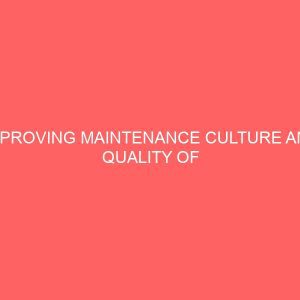


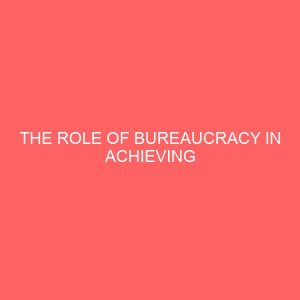
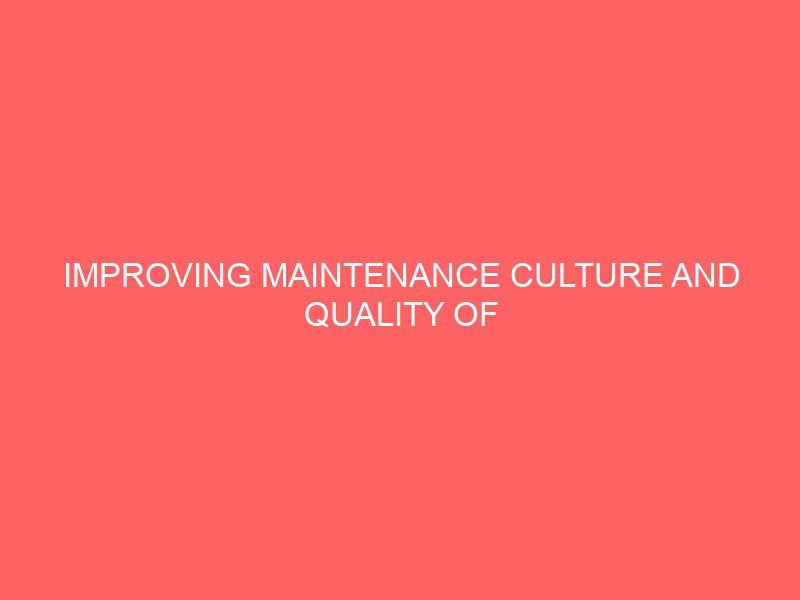
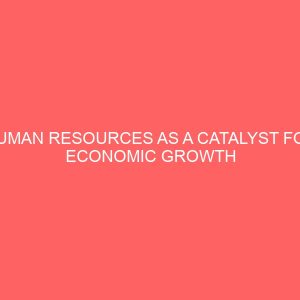
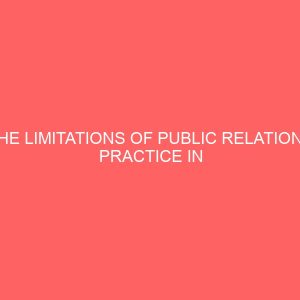
Reviews
There are no reviews yet.